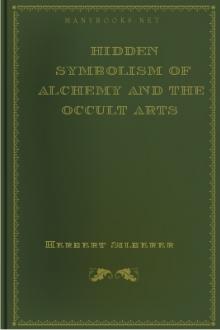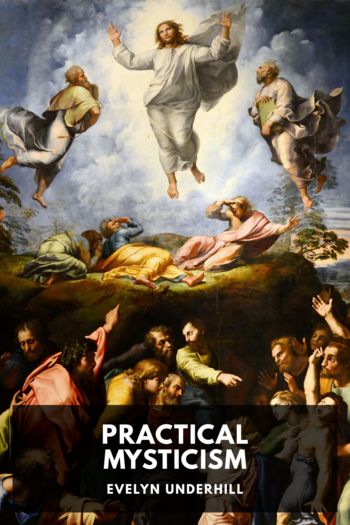Hidden Symbolism of Alchemy and the Occult Arts by Herbert Silberer (e book reader free .txt) 📕

- Author: Herbert Silberer
- Performer: -
Book online «Hidden Symbolism of Alchemy and the Occult Arts by Herbert Silberer (e book reader free .txt) 📕». Author Herbert Silberer
The three feathers are, of course, the three principles. Two of them move at once in opposite directions [towards the east and towards the west, as many writers on alchemy represent the two principles or breaths, anima and corpus or [Symbol: Gold] and [Symbol: Silver]] and so come even at the outset away from the right path. The third, symbol of the spirit, flies straight forward and has not far to its end, for simple is the way to the inner life. And so the spirit will speak to us if we follow its voice, at first quite a faint voice: “But the word is very nigh unto thee, in thy mouth and in thy heart that thou mayst do it.” (Deuteronomy XXX, 14.) Yet the soul is not free from sadness, as the man stands still on the lower steps of the ladder that leads up into eternal life. Simpleton is troubled in his heart and in the humility of this affliction he discovers “all at once” a secret door, which shows him the entrance into the mystical life. The door is on the surface of the earth, in abasement, as the third feather determined it in advance. As Simpleton discreetly obeyed it, he strolled along the path that the door opened for him. Three steps, three fundamental forces. So Christ had to descend before he could rise. The hero of the story knocks as Christ knocks in the gospel (i.e., [pg 228] on the inner door, contrasted with the law of Moses, the outer door). The big toad with her little ones in a circle about her signifies the great mother nature and her creatures, which surround her in a circle; in a circle, for nature always returns upon herself in a cycle. Simpleton gets the most beautiful carpet.
The other two beings that we call understanding and feelings (sun and moon of the hermetic writings) look without, instead of seeking the way within; so it comes to pass that they take the first best coarse cloths.
To bring the most beautiful ring is to bring truth, which like a ring has neither beginning nor end. Understanding and feeling go in different directions, the simpleton waits meekly by the door that leads to the interior of the great mother. [The appearance of this conception in the anagogic interpretation is also important.]
In the third test, the search for “the fairest woman,” the crown of life, conceived exoterically as well as esoterically, the carrot represents the vegetative life (body, the natural man), and the six mice that draw it are our old friends the six swans or virtues, and the highest of these compassion—or love—goes as the enthroned queen in the carriage. The uninitiated man is almost in doubt and asks, “What shall I do with a carrot?” Yet the great mother replies, as it were, “Take one of my fundamental forces.” And what do we see then? The toad becomes a beautiful maiden, etc. The man [pg 229] now all at once realizes how fearfully and wonderfully he is made. Filled with reverence of himself he is ready to cry, “Not my will but thine be done.”
Still another test remains. We must all go through a sort of mystical ring, which hangs in the hall (of learning). Only one in the whole universe is in a condition to accomplish it, to endure it without injury. The beautiful delicate maid with the miraculous gift is the spirit [spiritus or [Symbol: Mercury] of alchemy].
We shall add that the two interpretations externally contradict each other, although each exhibits a faultless finality. I should note that I have limited myself to the briefest exposition; in a further working out of the analysis the two expositions can be much more closely identified with the motives of the story.
First, then, the question arises, how one and the same series of images can harmonize several mutually exclusive interpretations (problem of multiple interpretation); yet we have discovered in the parable three practically equivalent schemes of interpretation, the psychoanalytic, the chemical (scientific), and the anagogic. Secondly, the question presents itself more particularly how can two so antithetic meanings as the psychoanalytic and the anagogic exist side by side.
The multiple interpretation of works of fantasy has become our problem, and the diametrical opposition of the psychoanalytic and the anagogic interpretation has particularly struck us. The question now apparently becomes more complicated if I show that the psychoanalytic interpretation contains an analogue that we must take into consideration. The analogue is presented by the remarkable coexistence of symbolism of material and functional categories in the same work of imagination. In order to make myself intelligible, I must first of all explain what these categories are.
In division 2 of the introductory part we have seen that the imagination shows a predilection for symbolic forms of expression, proportionately greater indeed, the more dreamlike it is. Now by this symbolism as we observe most clearly in hypnagogic (half dreaming) hallucinations and in dreams, three different groups of objects are represented.
I. Thought contents, imagination contents, in brief, the contents or objects of thinking and imagining, the material of thought whether it be conscious or unconscious.
[pg 234]II. The condition, activity, structure of the psyche, the way and manner that it functions and feels, the method of functioning of the psyche, whether it be conscious or unconscious.
III. Somatic processes (bodily stimulations). This third sort of objects is closely coördinated with the other two. It is not capable of interesting us in the present connection so we pass it by.
Therefore we arrive at two categories in which we can enroll all symbolizing works of the imagination, the material and the functional.
I. The material category is characterized by its representation of thought contents, i.e., of contents that are worked out in a train of thoughts (arranged thought, imagined), whether they are mere images or groups of images, concepts that are somewhat drawn out into comparisons and definition processes, or indeed judgments, trains of reasoning, which serve as analytic or synthetic operations, etc. Since, as we know, the phantasies (dreams, reveries, even poems) are mostly inspired by wishes, it will prove frequently the case that the contents symbolically contained in them are wish images, i.e., the imagined experiencing of gratification.
II. The functional category is characterized by the fact that the condition, structure or capacity for work of the individual consciousness (or the psychic apparatus) is itself portrayed. It is termed functional because it has nothing to do with the material or the contents of the act of thinking, but applies merely to manner and method in which consciousness [pg 235] functions (rapid, slow, easy, hard, obstructed, careless, joyful, forced; fruitless, successful; disunited, split into complexes, united, interchangeable, troubled, etc.). [It is immaterial whether these are conscious or unconscious. Thinking must be taken here in the widest possible sense. It means here all psychic processes that can have anything as an “object.”]
Two typical examples will enable us at once clearly to understand the two categories and keep them separate.
A. Material Symbolism.—Conditions. In a drowsy state I reflect upon the nature of the judgments that are transsubjectively (= for all men) valid. All at once the thread of the abstract thought is broken and autosymbolically in the place of it is presented the following hypnagogic hallucination:
Symbol. An enormous circle, or transparent sphere, floats in the air and men are putting their heads into this circle.
Interpretation. In this symbol everything that I was thinking of is expressed. The validity of the transsubjective concerns all men without exception; the circle goes through all the heads. This validity must have its cause in something common to all. The heads all belong to the same apparently homogeneous sphere. Not all judgments are transsubjective; with their bodies and limbs men are outside of and under the sphere and stand on the earth as separate individuals.
[pg 236]B. Functional Symbolism.—Conditions. Dreamy state as above. I reflect upon something or other, and yet in allowing myself to stray into bypaths of thought, I am diverted from my peculiar theme. When I want to get back the autosymbolic phenomenon appears.
Symbol. I am climbing mountains. The nearer mountains shut out my view of the more distant ones, from which I have come and to which I should like to return.
Meaning. I have got off the track. I have ventured too high and the ideas that I have entertained shut out my starting point like the mountains.
To the material category belongs, for example, the meaning of the strawberry dream explained in the second part of the introductory chapter. Strawberry picking is a symbol for an imaged wish gratification (sexual intercourse), and so for an image content. The symbolism is therefore a material one. The greatly preponderating part of psychoanalytic dream literature is occupied with interpretation according to material categories.
To the functional categories belong, for example, the symbolism of falling asleep and waking up, which I have mentioned in the second part in connection with the interpretation of the parable.
The two categories of symbolism, if they never did anything but parallel each other, would afford us no analogues for our problem of double meaning. Now the cases, however, are extremely rare where [pg 237] there is only functional or only material symbolism; the rule is an intimate interweaving of both. To be sure, one is frequently more emphasized than the other or more easily accessible, but we can generally find cases where long contexts of images are susceptible of material as well as functional interpretation, alike in detail and continuity of connection.
The following may serve as a very simple case in point. Lying one evening in bed and exhausted and about to fall asleep, I devoted my thoughts to the laborious progress of the human spirit in the dim transcendant province of the mothers-problem. (Faust, Part II.) More and more sleepy and ever less able to retain my thoughts, I saw suddenly with the vividness of an illusion a dream image. I stood on a lonely stone pier extending far into a dark sea. The waters of the sea blended at the horizon with an equally dark-toned mysterious, heavy air. The overpowering force of this tangible picture aroused me from my half sleeping state, and I at once recognized that the image, so nearly an hallucination, was but a visibly symbolic embodiment of my thought content that had been allowed to lapse as a result of my fatigue. The symbol is easily recognized as such. The extension into the dark sea corresponds to the pushing on into a dark problem. The blending of atmosphere and water, the imperceptible gradation from one to the other means that with the “mothers” (as Mephistopheles pictures it) all times and places are fused, that there we have no [pg 238] boundaries between a “here” and a “there,” an “above” and a “below,” and for this reason Mephistopheles can say to Faust on his departure,





Comments (0)